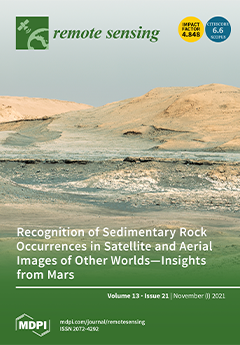Aeolian transport affects beach and foredune pre-storm morphologies, which directly contribute to storm responses. However, significant spatiotemporal variation exists within beach-dune systems regarding how biotic and abiotic factors affect topography. There are multiple metrics for quantifying topographic change, with varying pros and cons,
[...] Read more.
Aeolian transport affects beach and foredune pre-storm morphologies, which directly contribute to storm responses. However, significant spatiotemporal variation exists within beach-dune systems regarding how biotic and abiotic factors affect topography. There are multiple metrics for quantifying topographic change, with varying pros and cons, but understanding how a system changes across spatiotemporal scales relative to varying forcings is necessary to accurately model and more effectively manage these systems. Beach and foredune micro- and mesoscale elevation changes (Δ
z) were quantified remotely and in situ across a mid-Atlantic coastal system. The microscale field collections consisted of 27 repeat measurements of 73 elevation pins located in vegetated, transitional, and unvegetated foredune microhabitats over three years (2015 to 2018) during seasonal, event-based, and background wind-condition collections. Unoccupied aerial System (UAS) surveys were collected to link microscale point Δ
z to mesoscale topographic change. Microscale measurements highlight how Δ
z varies more pre- to post-event than seasonally or monthly, but regardless of collection type (i.e., seasonal, monthly, or event-based), there was lower Δ
z in the vegetated areas than in the associated unvegetated and partially vegetated microhabitats. Despite lower Δ
z values per pin measurement, over the study duration, vegetated pins had a net elevation increase of ≈20 cm, whereas transitional and unvegetated microhabitats had much lower change, near-zero net gain. These results support vegetated microhabitats being more stable and having better sediment retention than unvegetated and transitional areas. Comparatively, mesoscale UAS surfaces typically overestimated Δ
z, such that variation stemming from vegetation across microhabitats was obscured. However, these data highlight larger mesoscale habitat impacts that cannot be determined from point measurements regarding volumetric change and feature mapping. Changes in features, such as beach access paths, that are associated with increased dynamism are quantifiable using mesoscale remote sensing methods rather than microscale methods. Regardless of the metric, maintaining baseline data is critical for assessing what is captured and missed across spatiotemporal scales and is necessary for understanding the contributors to heterogeneous topographic change in sandy coastal foredunes.
Full article





